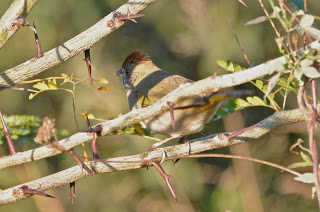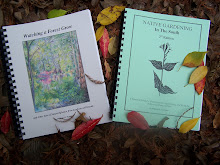Basketgrass
Well it's been a long time coming, now here we are. Been promising this post all summer....
Our climate is changing. Here in southern Louisiana we can expect a hotter and drier climate; indeed, we've already entered into that scenario. Without steady irrigation, our typically lush, tropical gardens will be a thing of the past. Well, tropical, yes; but lush, no. I don't know about you, but I've never been one to water an ornamental garden. Don't have the time nor the inclination. So what to do? Use plants that don't need any supplemental irrigation.
Below is my 'tough plants for tough times' list for Gulf Rim gardens (zones 8-9). These plants are not only drought-tolerant, but flood-tolerant as well...which is good, since we are still prone to occasional deluges (September 3-4, tropical storm Lee for example, dumped 6.5” on our garden; twenty-four hours after which it looked like it hadn't rained at all...). Listed plants are all very long-lived as well. Most will perform beautifully for at least 15 years; and in fact most have lived in our garden for 20 or more years. Lastly, in order to make this list, plants must have BIG aesthetic appeal: long blooming season and/or excellent texture and/or foliage color.
Dwarf Bottlebrush 'Little John'
(or, if you're from New Orleans, "Lil' Jawn")
Dwarf Bottlebrush 'Little John' (Callistemon vinialis) – I believe this is an Australian native – same as the full-sized Callistemon citrinus. Survived last year's exceptionally cold winter (yeah, I know, 'what about global warming, smarty-pants?' Note that a massive high-pressure dome was parked over Alaska all last winter, not only creating one of Alaska's warmer winters on record, but also conveyor-belting arctic air deep into the U.S. interior all the while....) here in horticultural zone 8b/9a. Excellent texture; sea-green foliage hue; blooms early spring – summer. Full-sun. Butterflies/hummingbirds.
typical Bottlebrush bloom
Lantana 'Miss Huff'
a probable L. camara X L. urticoides hybrid
Lantana (Lantana camara/urticoides) – I'm not talking about the dwarfish creeping types (
L. montevidensis, etc.) here – though for all I know they may be tough as well – but the naturalized shrub types that have inched their way up into the Louisiana coastal zone from Mexico and the Caribbean.
L. camara is the species that old-timers know as “Ham n' Eggs”.....
L. urticoides is an orange/red bloomer. Both are awesome for duration of bloom and general bad-ass toughness. Full to half-sun. Butterflies/hummingbirds.
Turk's Cap
Turk's Cap (Malvaviscus drummondii) – A hibiscus family member native to coastal Louisiana – specifically, in cheniere (live oak-dominated coastal forests). Winter-hardy all the way up to Shreveport. Runs like a Banshee in full sun, so be careful. Perfect for half-shade to bright filtered light, especially around the bases of shade trees, where little else will grow. There, it behaves itself nicely, laying down into a 3-4' groundcover. Butterflies/hummingbirds/songbirds.
Antique Rose 'Caldwell Pink'
'Caldwell Pink' Antique Rose – Amazingly, this 4' X 6' bush rarely if ever needs pruning! It barely even needs dead-heading. It's like the Ever-ready Rabbit, blooming and blooming despite drought or flood. Classed as a 'China' rose, which accounts for its everblooming habit. The only drawback is its lack of fragrance. Full-sun.
Pavonia hastata
Pavonia hastata – Pavonias are hibiscus family members. Over 270 species worldwide, including a couple of natives from the southwestern U.S. where it is commonly known as “rock rose.”
P. hastata, however, is from South America. Here along the Gulf Rim it grows to about 4' X 4'. Like shrub lantana and 'Caldwell Pink' rose, it always seems to be in bloom. Should it get unruly, just cut that sucker back to about 18” and it'll straighten up and fly right. Full sun. Oddly, I have not noted much butterfly/hummer activity.
Tropical Sage
The Mighty Salvias – There are about 700 Salvia species worldwide. This is the same genus containing the herb, “sage” (Salvia officinalis). Here in the U.S., ornamental Salvias are among the best hummingbird attractors in the garden. The most beautiful Salvias hail from the mountains of Mexico, Central America, and South America; but one species, called
Tropical Sage (Salvia coccinea) is native to coastal Louisiana. This species is one of the first plants that I'd recommend for a butterfly/hummingbird garden. Try to get native stock if you can. You'll see a number of cultivars offered in the trade. They're OK, but they are short-lived. Native tropical sage is sorta rangy, growing up to 5+ feet; but if you need it shorter, all you have to do is snap its weak stems down to the height you prefer. I've seen it used as a dense groundcover below live oaks, and maintained at 6” height with a weedeater. Native tropical sage will throw a lot of seed over time, developing into gorgeous clumps here and there. It's easy to transplant, easy to dead-head, and easy to weed-out. Blooms constantly. I even remember it blooming in January at our place one year. Shade to full-sun.
Anise Sage
Anise Sage (Salvia guaranitica) comes in a very close second to tropical sage on the “must have” list for butterfly/hummingbird gardens. This South American native blooms consistently spring/summer/fall here in south Louisiana. Does not seed. Shade to full-sun.
Salvia 'Argentine Skies'
Salvia 'Argentine Skies' is basically a powder-blue color form of anise sage. But anise sage makes modest clumps over the years, whereas 'Argentine Skies' runs hard. Use it to fill big spaces. Half-shade to full sun.
Horseherb
Horseherb (Calyptocarpus vialis aka Zexmenia hispidula) – is sometimes listed as a southern U.S. native, but I'm not so sure. As with Turk's cap, tropical sage, and shrub lantana, I believe that horseherb is a New World tropical species that probably got into the wild here on its own (migratory songbirds??). It showed up at our place about 20 years ago, but didn't really spread until after the Big Flood of May 2004. It's a shade-loving perennial groundcover. Lydia's scared of it. I love it...the plant, that is....not the fact that she's scared of it. I find it very easy to weed out of places where we don't want it. Lydia disagrees. We have agreed to disagree on many subjects during our 30+ years together. . .
Basket Grass
Basketgrass (Oplismenus setarius) – is yet another species from the American tropics that has naturalized here in the southern U.S. Are ya'll detecting a pattern here? Tough plants. Naturalized. If they're gonna make it, they've got to really really want to. Anyway, texturally basketgrass is a gorgeous thing. Like horseherb, it's a shade-lover. By the way, when they're in their 'happy place,' both horseherb and basketgrass colonize with enough density to preclude weeds.
Big Bluestem; producing its late-summer
bloom culms
Big Bluestem (Andropogon gerardii) – There are quite a few native grasses that make excellent garden plants, and its so sad that so few are used. Remember: grasses impart a “flowing” texture in the garden that few other plants can match. Grasses “finish” sunny gardens, just as ferns “finish” shady gardens. Incorporating grasses and ferns is the mark of a fine garden(er). Color's cool, but texture's tops! When not in bloom, big bluestem has a fine, fountain-type growth habit. Many genetic strains have very cool gray-green foliage and colorful red-yellow joints on their bloom culms.
Dwarf Maiden Grass 'Adiago'
(admittedly, not photographed at its best...but...trust me...)
Dwarf Maiden Grass (Miscanthus sinensis 'Adagio') – Maiden grass is native to Asia and Africa, and one of the most horticulturally-developed genera in the world. Hundreds of
M. sinensis cultivars have been developed over the years. A couple of these cultivars have proven to be invasive within U.S. east coast habitats; but not so in south Louisiana. My favorite maiden grass cultivar is 'Adiago,' a dwarf that grows to no more than 3' X 3'....an excellent “finishing” plant for sunny gardens.
Southern Shield Fern
(the Tropical Sage went ahead & seeded itself in)
Southern Shield Fern (Thelyptris kunthii) – A drought/flood-tolerant fern? Yep! This cosmopolitan species is native not only to Louisiana but also to the entire U.S. Gulf South, West Indies, Mexico, Central America, and down through much of South America! Pale-green – bordering on chartreuse-green – matte-finished fronds contrast beautifully with shinier, darker-green shade-loving companions. Toughest Gulf Rim fern you'll ever meet. Half-sun to full shade.






















































